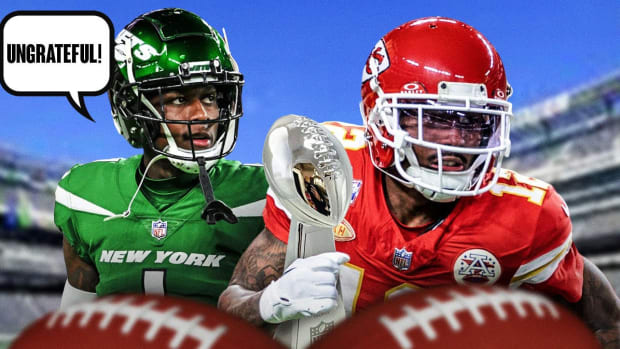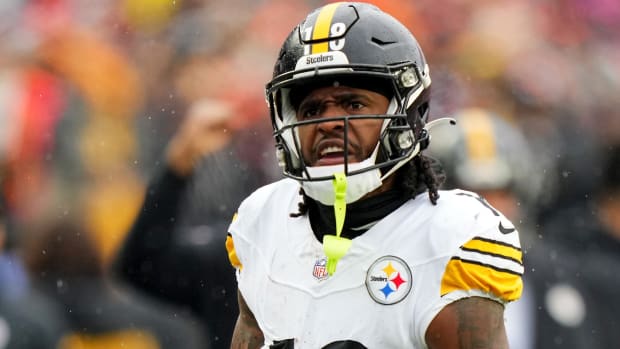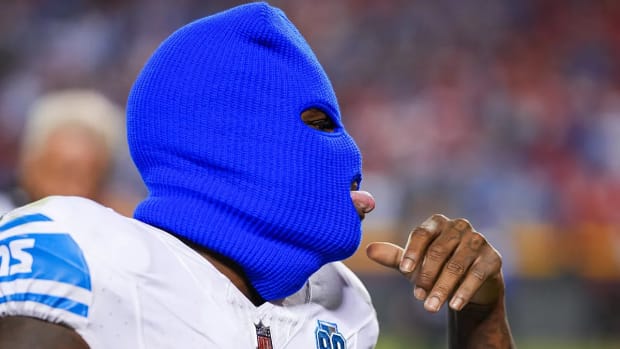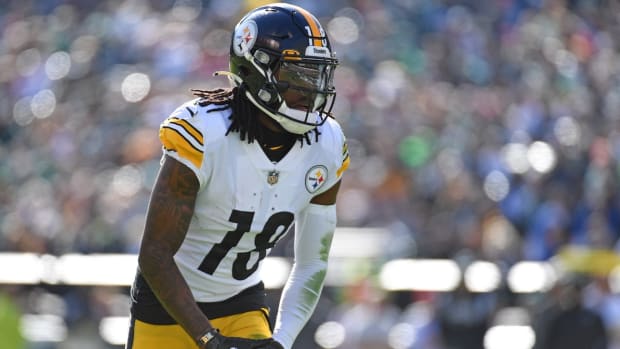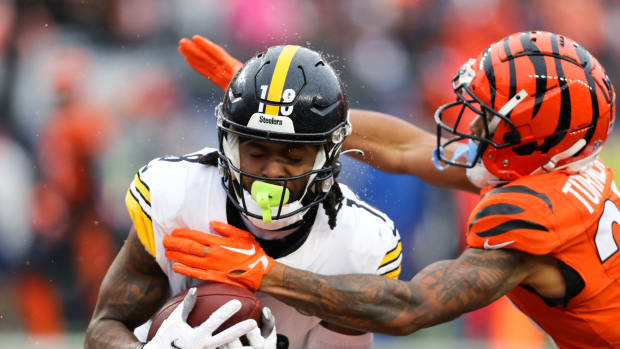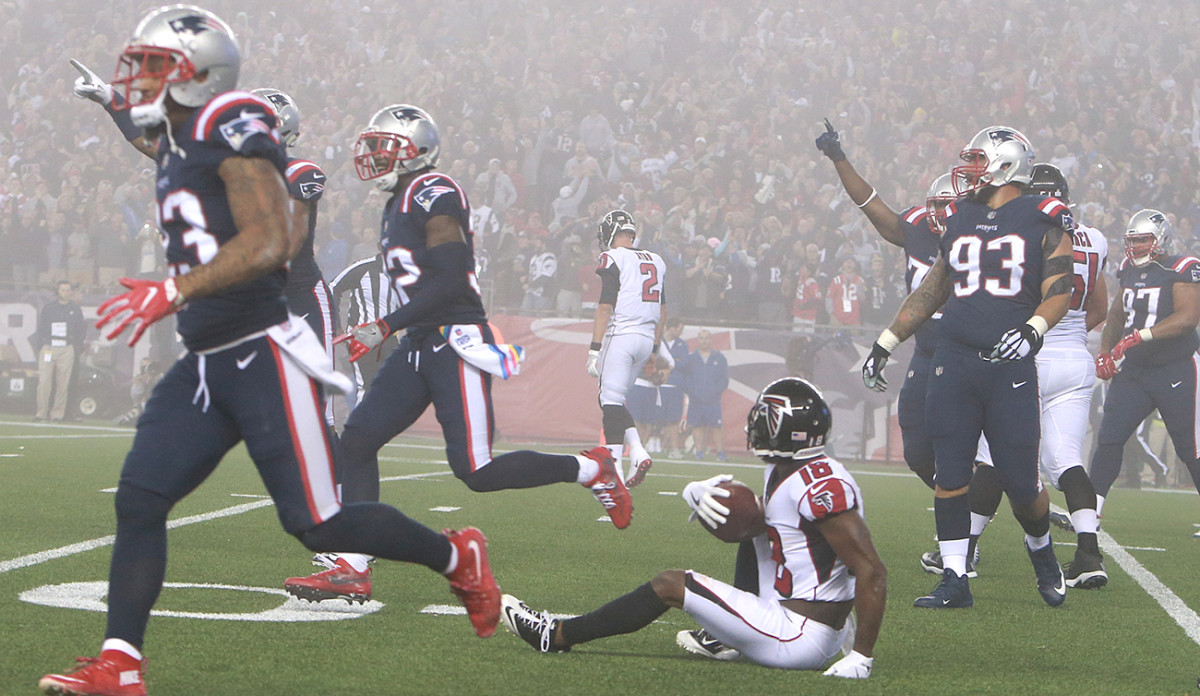
Four Downs: How Patriots Got Their Groove Back, Steelers Ignoring Martavis Bryant Trade Request
1. Patriots secondary the key to defensive rebound. That New England’s defense struggled early in 2017 wasn’t a stunner. The surprise was just how bad things got. The Patriots became the first team in NFL history to allow six consecutive 300-yard passing performances. There were communication breakdowns leading to coverage busts. When they had their issues on that side of the ball in the past, they’d managed to be fine because of sound situational football and few big plays allowed; they weren’t this time around. And then, all of that flipped.
On Sunday night, the Patriots stifled Atlanta’s offense, and the difference was pretty simple—the team got its money’s worth in the secondary. Stephon Gilmore, Devin McCourty, Duron Harmon and Patrick Chung have been paid, and Malcolm Butler will get his (whether it’s in New England or somewhere else) next year. And because all that money was sunk in the defensive backfield, the Patriots needed that group to be great, and it wasn’t early in the season. And those guys knew it.
“Oh yeah, trust me, we know,” Harmon told me after the win over Atlanta. “We’re supposed to be the strength. And we’ve got the players to be the strength of this defense, and we just have to play to it.” Harmon then explained that the Patriots’ loss to Carolina on Oct. 1 represented rock bottom—“After the Panther game, we just said, ‘We can’t do this anymore’”—and an emphasis was put on getting assignments straight and communication humming. On two big plays in the Carolina game, Gilmore and fellow corner Eric Rowe were literally covering the same guy, leaving another receiver (first Devin Funchess, then Kelvin Benjamin) wide open. Then, there was the Panthers touchdown on a double screen to Fozzy Whitaker, which played out like the quintessential “nobody’s home” situation for a snookered defense.
“We were giving up wide open touchdowns, guys were running scot free,” Harmon said. “We can’t do this anymore. We’re too talented. We’re too good. We can’t cost our team games like this, and especially home games . . . It wasn’t Patriot football. We had to look in the mirror, figure out what the problem was, and we started to change it.”
One interesting caveat to all this is that Gilmore—an uncharacteristic Patriot free-agent splurge due to make $32 million combined in 2017 and ’18—missed the team’s last two games as the secondary corrected its problem. His reentry into the lineup, given his culpability in the previous problems, bears watching. And based on the some the talent issues in the front seven, this group isn’t going to suddenly become the 2000 Ravens. But one thing’s for sure: It’s better than it was, and that’s great news for Tom Brady and an offense that had been carrying a very heavy burden. As Harmon assesses it, “We’re really going in the right direction now.”
2. Falcons play-calling mess. First, some perspective. The Falcons are still seventh in total offense, and they’re still talented on that side of the ball, and they’re 3-3, which hardly eliminates them from anything. O.K., now that we have that out of the way—the optics of Sunday night weren’t good, and there are fair questions to raise on where Steve Sarkisian, Matt Ryan and Co. go from here.
There are specific plays (a low-percentage deep throw on a fourth-and-6, a jet sweep on fourth-and-goal from the 1) that highlight that. But I think the bigger issue was the expectation, both internally and externally, that the first post-Kyle Shanahan steps would be smooth.
After Shanahan got the Niners job, Falcons coach Dan Quinn had a decision to make: maintain the status quo with a record-breaking offense built around a slew of scheme-specific players by promoting a position coach, or go outside the program and inject new blood with an experienced leader. And then, Quinn kind of sidestepped it. Atlanta didn’t consider promoting receivers coach Mike McDaniel (who coordinated Shanahan’s run game) or quarterbacks coach Matt LaFleur (Ryan’s position coach for his MVP season), or splitting the job between the two. The feeling was the building had been, back in 2015, too cliquey and they didn’t want it to revert, and neither coach had play-calling experience.
Still, Quinn didn’t abandon the offense, informing both Sarkisian and Chip Kelly during the interview process that running it would be a condition of taking the job. On paper, it makes sense: Hire a guy who’s a cultural fit (Sarkisian, another ex-Pete Carroll assistant) to improve staff chemistry, and have him learn a scheme that he has some background in, having a run a different iteration of the west coast offense. The problem? As it’s been explained to me, the level of detail and intricacy in how the run and pass games are married within Shanahan’s offense makes being able to learn it—then teach it—incredibly difficult for any coach who didn’t come up in that system. It’s a dynamic that accounted for some of the fits and starts Atlanta went through in Shanahan’s first year there. And the challenge became stiffer when LaFleur and McDaniel, the two assistant most experienced in the system and both under contract, were allowed out for higher level jobs with the Rams and Niners, respectively.
None of this means Sarkisian can’t succeed long-term. And to their credit the players are taking ownership of the problem too. Devonta Freeman explained it to me like this: “We have to go back to the drawing board, figure things out. I mean, we have the same players, we’re the ones going out there making plays. One man won’t stop the show.” But losing a few can certainly slow things down, which is what seems to be playing out here. That’s why it was probably wrong for anyone inside or outside the building to expect Sarkisian to, right away, be able to run Shanahan’s offense like Shanahan himself did.
3. Steelers are ignoring Martavis Bryant’s trade request—and plan to continue ignoring it. Know what’s weird? Bryant hasn’t been a problem in the building, or on the field for Pittsburgh. In fact, one coach went so far as to call him “a changed person” when I asked about him this week. So for many in Pittsburgh, the trade request (and the social media outburst to follow) came out of left field. And there’s certainly speculation inside the organization that this is all the result of Bryant getting bad advice from the people around him. And assuming this is coming from those around Bryant, there’s no question that the advice he’s getting is bad. Off-field problems/flags dropped Bryant into the Steelers’ lap in the fourth round of the 2014 draft. After coming on at the end of his rookie year, he was suspended for the first four games of 2015 for violating the drug policy. Then, after catching 50 balls for 765 yards and six touchdowns in just 11 games in 2015, he was busted again and suspended for the entire 2016.
Since his conditional reinstatement in April, and his full reinstatement on Sept. 1, he’s been the second most targeted receiver on the Pittsburgh roster, behind only Antonio Brown, who might be the best receiver in football. And now, he’s going to try to shove his way out of there? “If things don’t get better,” he told ESPN’s Josina Anderson, “then I got to go.” Remember, Bryant isn’t eligible to do a new deal until after this year, and isn’t a free agent until March 2019—his four-year contract, signed in 2014, tolled as a result of his 2016 suspension. And any team trading for him would certainly already be concerned about the fact that he’s now one failed drug test away from banishment from the league, and this won’t help soften his image with potential suitors. Plus, there’s the fact that his trade request became public after he played in his sixth game, which is the marker he needed to hit to accrue the season towards free agency, suggesting this was a calculated move. Add all of it up, and it’s easy to see why Pittsburgh believes that Bryant is listening to the wrong people. And it’s just as easy to see why—since acquiescing to his demand would set bad precedent, and Bryant just further killed own his trade value anyway—the Steelers have no plans to listen to him.
4. More mobile coming? Last week, we wrote extensively about the drop in the NFL’s television ratings and the concern among owners. And so a few days later, during the Patriots Pregame Show, my buddies Chris Gasper (of the Boston Globe) and Marc Bertrand (of 98.5 the Sports Hub) peppered New England president Jonathan Kraft, chair of the league’s digital committee, with questions about it. Just how worried are the owners?
“Television as a medium is very rapidly transforming, and when you think of a generation of people that grow up watching anything they want on demand, the idea of setting your schedule around a live event week-in and week-out is a little antithetical,” Kraft said. “So we’re working on ways, and I think you’re gonna hear some news in the coming weeks, where you’re going to be able to watch our games, or many of our games, on your wireless device in your home market. You’re going to see different forms of presentation of our content that will hopefully allow us to adapt to the consumers’ tastes. We clearly are focused on it, but I think as a traditional television product, we’re very strong. But in 10 years, the concept of traditional television probably won’t exist.” (Kraft later clarified that he believes the networks themselves will exist, but the delivery of their content would change.)
The NFL has been very protective of its game footage over the years, and it currently has deals in place that will necessarily restrict growth in this area. Verizon, in particular, pays about $250 million annually for exclusive phone streaming rights. But that deal is up after this year and, as I understand it, was a big part of the discussion in New York between owners and executives last week. It centered on allowing games to be streamed on more phones, and finding a way to get the league’s broadcast partners (NBC, CBS, FOX, ESPN) to sign off on that. “[The networks] don’t get ratings for that,” said one team executive, “so the bigger picture for us, and them, is that we need people to learn how to quantify viewership beyond just television in a way where we can sell it to advertisers.” At the very least, know this: The concern over the ratings is real, and the league understands a younger slice of that audience might not be coming back to linear television, so they’ll have find other ways to reach them. Which is, indisputably, progress.
































